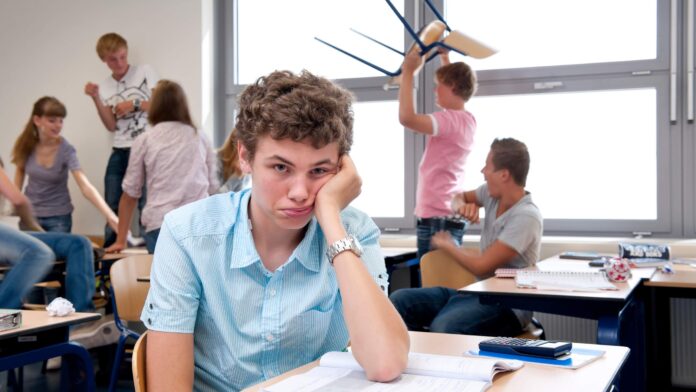President Trump signed a directive on April 23 directing public school districts to develop policies for student discipline that do not take race or ethnicity into consideration. According to the order, “The Federal Government won’t tolerate risks that are known to exist for children’s safety or well-being when school discipline is based on a discriminatory and illegal ‘equity ideology’.”
It is right for the administration to take action. To restore order in America’s classrooms, it is necessary to reverse years of misguided policies by the federal government that were based on racial-quotas and therapy interventions. These policies have hurt academic achievement, put students at risk, and made it harder for struggling students to receive help. To be successful, the administration needs to respect local control, while also overcoming the strong opposition of a deeply-rooted education bureaucracy whose radical agenda is its main goal.
A 2012 report by the Obama administration found that black students are “suspended and expelled” at a higher rate than white students. In response, the administration sent a “Dear Colleague” letter to state and local education agencies in 2014, warning of federal investigations if rates of “exclusionary discipline”–suspensions and expulsions–were racially disproportionate.
Obama’s new policy has not been well received. The results of the racial-bean-counting program have not been impressive. A North Carolina School District attempted to improve discipline through a policy which paid a non profit over $800,000. Winston-Salem/Forsyth County Schools had fewer suspensions during the school year and no expulsions, part of a broader shift toward “equitable discipline.”
The district did report a higher rate of crime than in the previous year. Critics claim that the changes have made conditions worse for students, because they are not addressing disruptions in class.
School violence and classroom disorder are at an all-time peak, according to surveys.
According to a recent EdWeek Research Center survey, student behavior has deteriorated nationwide. This is according to teachers and administrators. Before the pandemic hit, there was a noticeable increase in student behavior, from minor disruptions in classrooms to serious fights on social media.
The survey revealed that 72% educators believe that students have misbehaved “a little bit” (24%) or a “lot” (48%) more in the fall semester of 2019 than they did in the fall semester of 2019.
In fact, misbehavior by students is the number one reason teachers quit their profession.
Students are very uncomfortable with the chaos. In Los Angeles for example, 58.5% elementary students, 55.2 % middle school students and 51.6% high school students felt safe in their school in 2023-2024, a marked decline compared to previous years. Fighting and physical aggression rose by 16.8% between the 2022-2023 to 2023-2024 school years, while threats increased by 28.5%. The number of incidents involving illegal substances or controlled substances increased by 23.8% over the same time period.
The presence of a disruptive child in a classroom can have ill effects on the environment for learning and the behavior of other students. The time and energy of teachers are diverted from teaching to deal with the disruptive students, which can negatively impact the learning environment.
We must change the system that allows students to behave in the most outrageous ways, because they believe they are victims or “ableism” or racism.
We must instead use the “no-excuses” approach. In the 1990s, the term was used to urge educators not to use excuses such as poverty or broken families for the chaos that existed in urban schools, which made learning impossible.
David Whitman’s 2008 Fordham Institute publication, Sweating The Small Stuff captures this concept very well. Whitman believes that “disorder is the death of urban schools located in poor neighborhoods, not poverty or violence.”
Schools must return to their traditional values and establish academic standards. They should also closely monitor student behavior. Students should listen to their teachers, do their homework, be diligent in studying, avoid fighting, and adhere to all school rules.
As RealClearInvestigations details, Columbus Collegiate Academy Main in Ohio exemplifies traditional education methods. The orderliness of the school is obvious. The students in khakis, blue tops and bulging backpacks are eagerly lining up at the front of the brick building. Students are required to remain silent, sit at their desks upright, and show respect for each other.
The majority black and Latino students appear to be seriously engaged in class. They are either holding pencils or typing on keyboards. Teachers are moving quickly through the lessons. Answering questions, hands shoot up. “No one is joking around or causing trouble, which is remarkable for a middle-school full of teenagers.
The academy is one of about 1,000 urban charter schools with high performance that follow the No Excuses Model.
After a year of chaos, many urban public schools have been ravaged by behavior problems. Teachers claim that this is their greatest challenge. No Excuses Charters show how to restore order.
Although President Trump’s executive order is a good step, local school decisions will determine the outcome.
***
Larry Sand is a retired classroom teacher with 28 years of experience. He is president of California Teachers Empowerment Network, a non-profit, non-political organization dedicated to providing teachers, and the public, with accurate and balanced information regarding professional affiliations, and positions on educational matters. These views are solely his.
NEWSLETTER SIGNUP
Subscribe to our newsletter! Get updates on all the latest news in Virginia.


